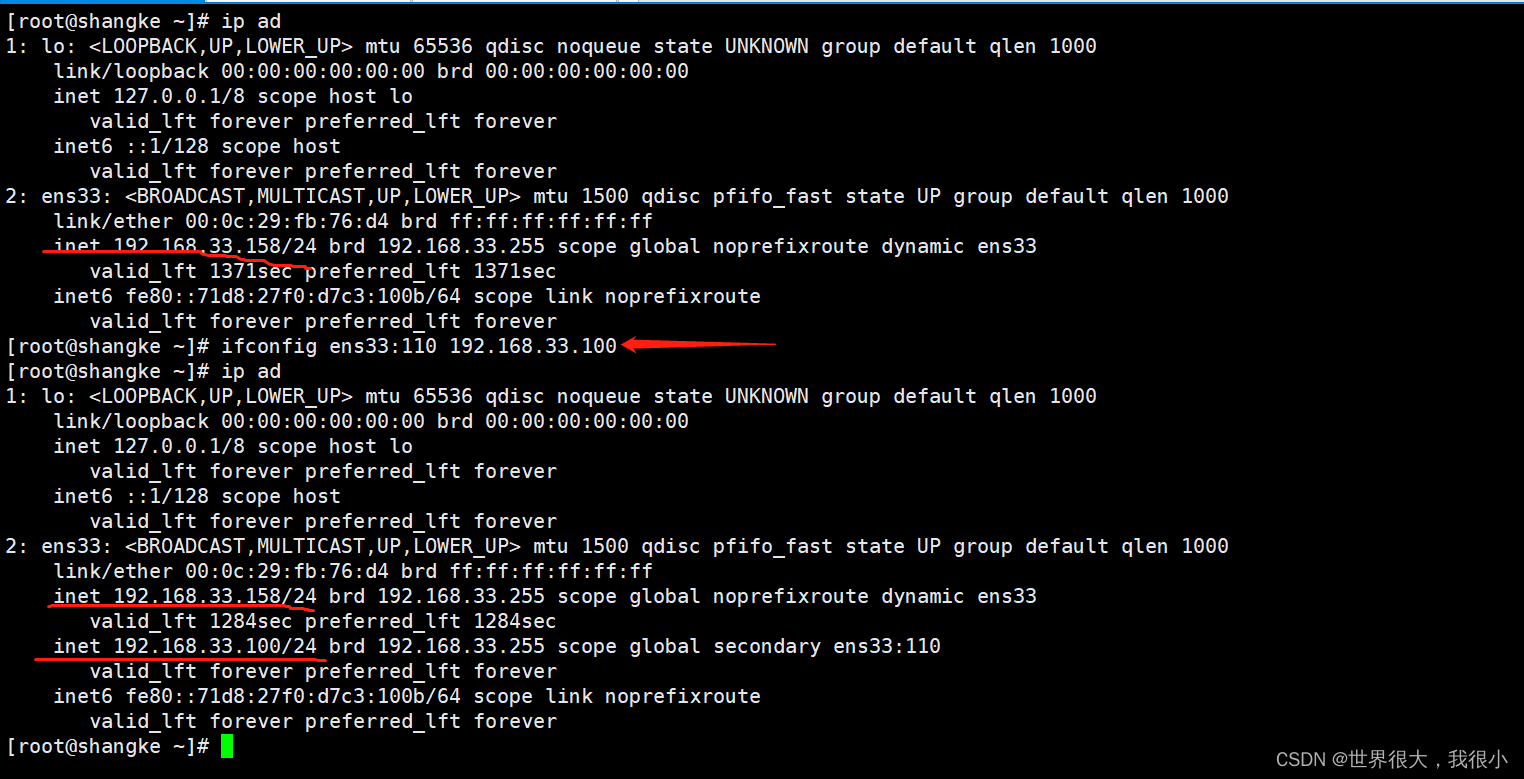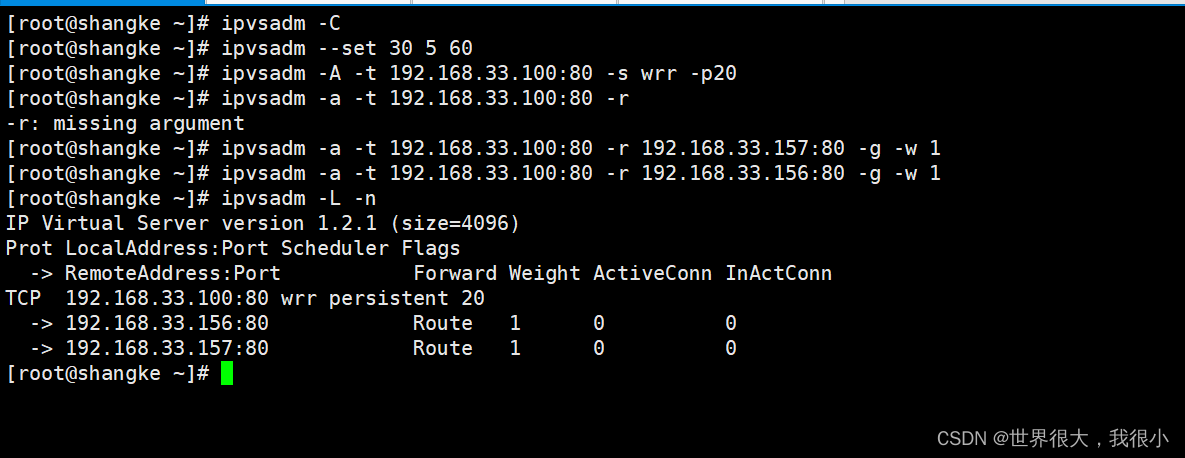centos7实现负载均衡
| 阿里云国内75折 回扣 微信号:monov8 |
| 阿里云国际,腾讯云国际,低至75折。AWS 93折 免费开户实名账号 代冲值 优惠多多 微信号:monov8 飞机:@monov6 |
目录
一、基于 CentOS 7 构建 LVS-DR 集群。
环境
| 作用 | 环境 | |
| windows | 测试 | |
| 192.168.33.158 | LVS负载均衡 | centos7 |
| 192.168.33.157 | web服务器1--rs1 | nginx1.22centos7 |
| 192.168.33.156 | web服务器2--rs2 | Apache2.4 redhat9 |
1.1 配置lvs负载均衡服务
1.1.1 下载ipvsadm

1.1.2 增加vip
ifconfig ens33:110 192.168.33.100
注意增加的IP和本机的IP需要在同一个网段。
1.1.3 配置ipvsadm

1.2 配置rs1
1.2.1 编写测试页面

1.2.2 手工在RS端绑定VIP、添加路由

1.2.3 抑制arp响应

1.3 配置rs2
配置和rs1一样省略。

注意调整内核参数关闭arp响应的时候redhat和centos的网络设备名称是不一样的。
1.4 测试


二、配置nginx负载均衡。
2.1 配置好环境
| 作用 | 环境 | |
| windows | 测试 | |
| 192.168.33.158 | nginx负载均衡 | nginx1.22centos7 |
| 192.168.33.157 | web服务器1--web1 | nginx1.22centos7 |
| 192.168.33.156 | web服务器2--web2 | Apache2.4 redhat9 |
确保所有的防火墙和selinx都是关闭的。
2.2 web服务器上添加测试页面
web1

web2

2.3 配置负载均衡器
主配置文件/usr/local/nginx/conf/nginx.conf
user nginx;
worker_processes 1;
#error_log logs/error.log;
#error_log logs/error.log notice;
#error_log logs/error.log info;
#pid logs/nginx.pid;
events {
worker_connections 1024;
}
http {
include mime.types;
default_type application/octet-stream;
#log_format main '$remote_addr - $remote_user [$time_local] "$request" '
# '$status $body_bytes_sent "$http_referer" '
# '"$http_user_agent" "$http_x_forwarded_for"';
#access_log logs/access.log main;
sendfile on;
#tcp_nopush on;
#keepalive_timeout 0;
keepalive_timeout 65;
#gzip on;
include /etc/nginx/conf.d/*.conf;
server {
listen 80;
server_name localhost;
#charset koi8-r;
#access_log logs/host.access.log main;
location / {
root html;
index index.html index.htm;
}
#location / {
# root /data/web2;
# index index.html index.htm;
# auth_basic "Restricted";
# auth_basic_user_file /data/web2/webpass;
#}
location ~ \.php$ {
root html;
fastcgi_pass 127.0.0.1:9000;
fastcgi_index index.php;
fastcgi_param SCRIPT_FILENAME $document_root$fastcgi_script_name;
include fastcgi_params;
}
#error_page 404 /404.html;
# redirect server error pages to the static page /50x.html
#
error_page 500 502 503 504 /50x.html;
location = /50x.html {
root html;
}
# proxy the PHP scripts to Apache listening on 127.0.0.1:80
#
#location ~ \.php$ {
# proxy_pass http://127.0.0.1;
#}
# pass the PHP scripts to FastCGI server listening on 127.0.0.1:9000
#
#location ~ \.php$ {
# root html;
# fastcgi_pass 127.0.0.1:9000;
# fastcgi_index index.php;
# fastcgi_param SCRIPT_FILENAME /scripts$fastcgi_script_name;
# include fastcgi_params;
#}
# deny access to .htaccess files, if Apache's document root
# concurs with nginx's one
#
#location ~ /\.ht {
# deny all;
#}
}
# another virtual host using mix of IP-, name-, and port-based configuration
#
#server {
# listen 8000;
# listen somename:8080;
# server_name somename alias another.alias;
# location / {
# root html;
# index index.html index.htm;
# }
#}
# HTTPS server
#
#server {
# listen 443 ssl;
# server_name localhost;
# ssl_certificate cert.pem;
# ssl_certificate_key cert.key;
# ssl_session_cache shared:SSL:1m;
# ssl_session_timeout 5m;
# ssl_ciphers HIGH:!aNULL:!MD5;
# ssl_prefer_server_ciphers on;
# location / {
# root html;
# index index.html index.htm;
# }
#}
}
子配置文件/etc/nginx/conf.d/vhost.conf
server {
listen 80;
server_name test.ng.test;
location / {
proxy_pass http://web_server;
}
}
upstream web_server {
server 192.168.33.157;
server 192.168.33.156;
}
2.4 开启nginx服务和web服务
systemctl start nginx
systemctl start httpd
2.5 测试
用windows测试的时候需要修改本地的hosts文件。路径C:\Windows\System32\drivers\etc

windows 浏览器的测试


因为是一般轮询负载均衡所以不断刷新页面页面会在192.168.33.157和192.168.33.156之间交替出现。

